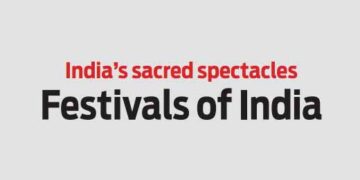 THE rich cultural tapestry that is India, with its images of colour and diversity, of ancient splendour and contemporary dynamism, unfolds itself in a motley procession of festivals. The pageantry that goes alongside together reveals to us the India of yesterday, today and tomorrow – documenting Indian culture in minutiae and delineating in form & content the eternal joys of human existence.
THE rich cultural tapestry that is India, with its images of colour and diversity, of ancient splendour and contemporary dynamism, unfolds itself in a motley procession of festivals. The pageantry that goes alongside together reveals to us the India of yesterday, today and tomorrow – documenting Indian culture in minutiae and delineating in form & content the eternal joys of human existence.
The Indian civilisation with its plethora of festivals, with each region having its typical forms in both classical and folk traditions, has survived the winds of change and continued to manifest themes closest to the Indian heart. Myths and legends of gods & goddesses, feats of epic heroes and warriors, moments from two classical epics, Ramayana & Mahabharata, sacred stories of saints and holy persons, are ‘recreated’ and expressed in accompaniment with song, music and dance.
Much before the Greeks and Romans, the year was divided in India by popular festivals heralding the changing seasons and keeping humanity in tune with nature’s moods, e.g. harvest-time (Sankranti), spring and summer (Vasant Panchami and Holi), and autumn’s end (Deepavali). There is acting and singing and performance of folk songs & dances like rasa-lila, the dalliance of Krishna with gopis (cowherdesses).
Transition in affairs
The harvest festival of Makar Sankranti occurring in midJanuary is celebrated by different names, e.g. Magh Bihu in east/ northeast, Pongal in Tamil Nadu, Makaravilakku in Kerala, Uttarayana in Gujarat, Lohri in Delhi/Punjab/ Haryana/Himachal, and Sankranti elsewhere. It is an auspicious eve of transition in human and social affairs, and millions take a dip in Ganga and other rivers. Soon there is Vasant Panchami or Saraswati Puja (worshipping the goddess of learning) and the spring festival of Holi when people squirt coloured water (rang)/powder (abir).
Then comes the New Year’s Day according to Hindu Vikram Samvat calendar (Chaitra Shukla Pratipada) on March 21/22every year, followed by Chaitra Navaratras and Ramnavami (birth of Rama). Another important festival is Raksha Bandhan/Bhaiyaduj, when sisters tie colored threads (Rakhi) on their brothers’ wrists who pledge to protect them. Then comes Janmashtami (birth in prison of Krishna at midnight), especially at Mathura/Vrindavan.
The greatest Hindu festival is the Sharad Navaratras culminating in Vijayadashmi. Spanning ten days and accompanied by Ram Lila celebrations, this carnival time is known as Dassehra or Durga Puja when devotees worship Mother Goddess for nine nights and tableaux and processions re-enact the old stories of Goddess Durga slaying the demon king Mahisasura and of Rama killing Ravana, both stories symbolising the victory of good over evil.
Brightest Indian festival
These festivities are followed by Deepavali, the festival of lights, celebrating the return of Rama to his kingdom at Ayodhya after subduing Ravana and rescuing his consort Sita. It is the brightest Indian festival, when households are aglow with lights mostly lit up in earthen cups (diyas) – its special feature being worship of Lakshmi, the goddess of prosperity. Six days after the festival of lights is celebrated the mass festival of Chhath or Surya Shasthi in eastern and northern parts.
The mosaic of Hindu festivals is also enriched by the festivals of other faiths such as Christmas toward the year’s end, celebrating the birth of Christ, and Good Friday when Christians mourn the crucifixion of Christ. The Muslim festival of Id-dul-Fitr (period of fasting) comes at the end of the holy month of Ramzan, an occasion for feasting during iftar (breaking of fast) when Muslims mingle with their brethren and eat among other things bowls of sweet vermicelli.
There is Id-ul-Zuha or Bakarid commemorating Prophet Ibrahim’s offer to sacrifice his son and Muharram remembering Hussain’s martyrdom when tazias, symbolic of tombs at Karbala, are carried in mourning processions. There is also the Zoroastrian New Year festival of Parsis, called Nowroz, and important festival of followers of Sikhism (Prakash Diwas or Nanak Jayanti), Buddhism (Buddha Purnima and Parinirvana Diwas), and Jainism (Mahavir Jayanti and Paryushan Parva). All these festivals reveal a unique catholicity of social behaviour and taste for liveliness.
















